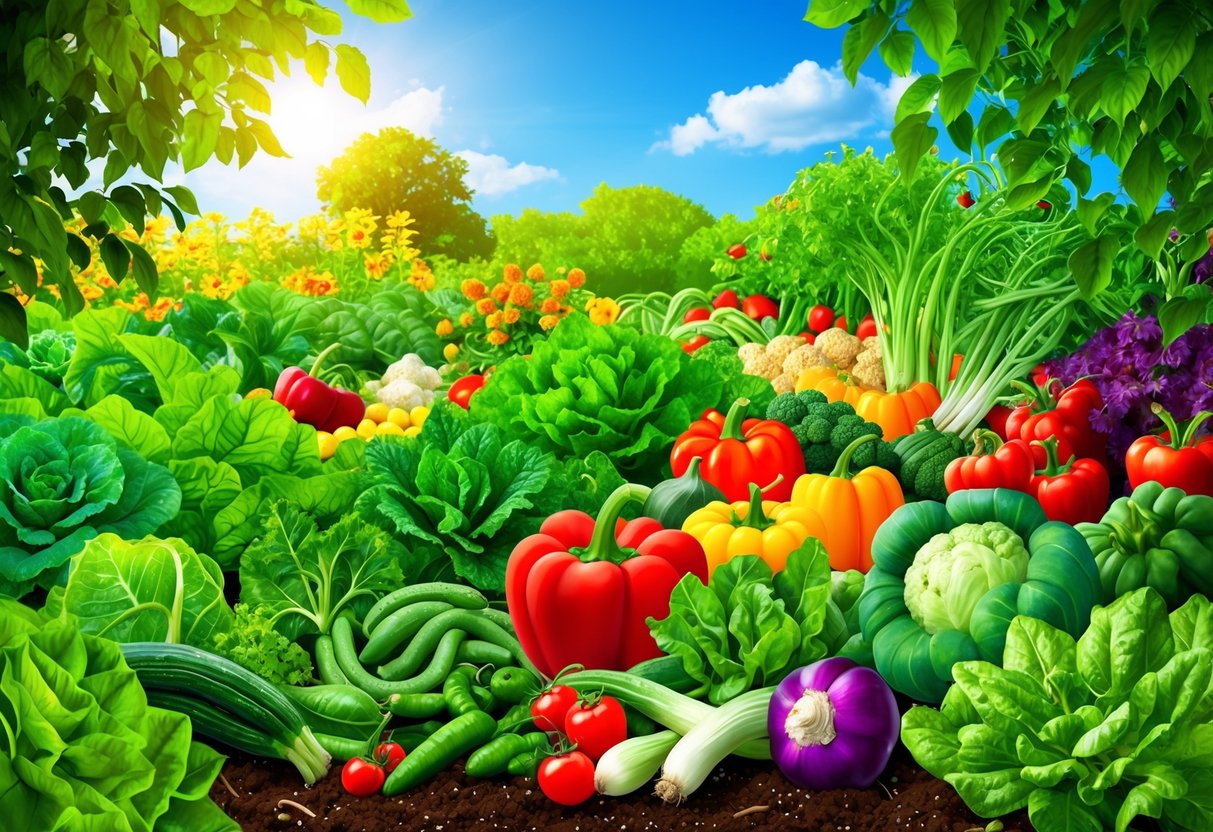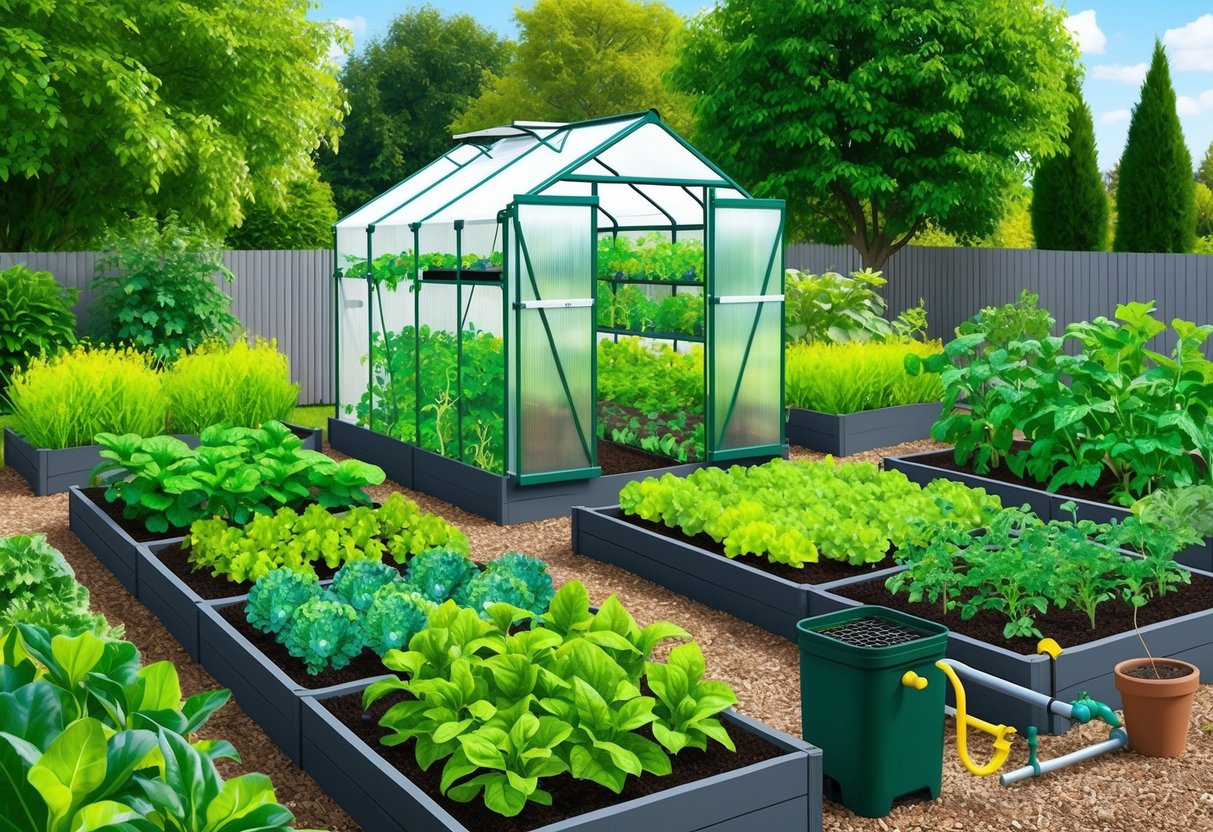
Watering and Maintenance for Gourmet Quality
Consistent, targeted care can lead to more flavorful, visually appealing organic vegetables. Proper watering routines and careful plant maintenance are essential for optimal growth and disease prevention during each stage of the season.
Efficient Watering Methods
Delivering water efficiently to vegetable crops is vital for both crop quality and sustainability. Deep, less frequent watering encourages robust root systems and resilient plants.
Drip irrigation and soaker hoses are preferred for reducing water loss and providing even soil moisture. Always check the soil before watering; the top inch should be dry before the next watering session.
Overwatering can lead to shallow roots or fungal issues, while underwatering can stress plants and cause bitter or stunted produce. Morning is the best time to irrigate, as this allows foliage to dry quickly and reduces disease risk.
Adding mulch retains moisture and reduces temperature swings. Always tailor your watering practices to the specific needs of each vegetable species.
For more information on efficient techniques, see these tips for deep watering and root health.
Pruning, Thinning, and Staking
Pruning, thinning, and staking plants increases airflow and sunlight exposure, promoting stronger stems and dense, flavorful produce. Remove outer and lower leaves regularly to stimulate new growth and prevent buildup of pests or diseases.
Thinning crowded seedlings is key; this gives each plant enough room and nutrients for optimal development. Sturdy stakes, trellises, or cages are vital for supporting heavy fruiting plants like tomatoes or beans, keeping them off the ground and minimizing rot.
Consistent pruning of fast-growing vines, such as cucumbers or squash, helps maintain plant shape and fruit quality. Frequent inspection for yellow or damaged leaves and immediate removal keeps plants vigorous.
Discover additional pruning best practices from the complete guide to organic vegetable gardening.
Harvesting Gourmet Vegetables at Peak Flavor
Proper harvesting ensures maximum flavor and the longest possible shelf life for gourmet vegetables. Knowing when and how to pick produce helps preserve the unique qualities that make homegrown crops stand out.
Determining the Right Time to Harvest
Each type of gourmet vegetable has an ideal stage for harvest that balances sweetness, texture, and nutritional content. Leafy greens like arugula and lettuce should be picked when young and tender, before the leaves become tough or bitter.
Root crops such as carrots and beets are best lifted when they have reached full size but before they become woody; the foliage turning vibrant green and stiff is a sign they are ready. Tomatoes are most flavorful when harvested fully colored and slightly soft to the touch.
Herbs such as basil and cilantro should be snipped early in the morning, just before they flower, for peak essential oil content. Regular, strategic picking with clean, sharp tools promotes an abundant harvest throughout the growing season.
For more information on optimizing harvest times, visit this detailed vegetable harvesting guideline.
Post-Harvest Handling for Freshness
Gentle handling after harvest helps extend freshness and reduce spoilage. Vegetables like beans and cucumbers should be cut rather than snapped from the plant to avoid bruising and encourage longer storage.
Immediately after harvest, remove excess soil and cool vegetables as soon as possible to slow the loss of flavor and moisture retention. Using breathable containers, like meshed baskets or cloth bags, allows air circulation which further preserves texture and taste.
Store vegetables such as carrots and beets unwashed in a cool, dark space with high humidity to help them last for weeks. Delicate items, like leafy greens, benefit from quick refrigeration and slight dampness to retain crispness and prevent wilting, as detailed in this post on harvesting and storing vegetables for peak flavor and freshness.
Extending the Growing Season and Off-Season Care

Gourmet vegetable gardens can flourish with the right strategies for maximizing harvest time and maintaining soil health between plantings. Using season extension techniques and implementing rotation methods helps ensure a continuous supply of high-quality, organic produce.
Season Extension with Covers and Indoor Solutions
Gardeners use a variety of methods to extend the vegetable growing season. Cold frames, row covers, and cloches help protect plants from frost and keep soil temperatures more stable.
Lightweight agricultural fabrics, such as floating row covers, are popular because they shield crops from both cool temperatures and pests without smothering the plants. For an even longer growing window, many turn to indoor solutions.
Starting seeds indoors under grow lights can jumpstart the season before the last frost date. Similarly, transplanting young seedlings into protected environments like greenhouses or hoop houses allows for earlier production and prolongs harvests into autumn.
These strategies can even allow gardeners to harvest delicate greens or hardy vegetables through mild winters, depending on the region. Succession planting—replanting vegetables as soon as earlier crops are harvested—can also be paired with these techniques.
This practice not only staggers harvest times but also stretches homegrown gourmet vegetable yields well beyond their typical outdoor limits. Readers can learn more about these methods in guides dedicated to extending the growing season.
Crop Rotation and Soil Renewal Between Seasons
Healthy, organic soil is the backbone of productive gourmet vegetable gardens. Practicing crop rotation—changing the type of crop grown in each plot every season—helps break cycles of disease and mitigates pest build-up.
For example, rotating leafy greens with root crops or legumes improves soil structure and nutrient levels. Between major planting seasons, adding organic matter such as compost or aged manure replenishes nutrient stores.
Some gardeners plant cover crops, like clover or vetch, during off-seasons to fix nitrogen and prevent soil erosion. This off-season care keeps soil loose, fertile, and ready for the next round of gourmet vegetables.
Mulching with straw or shredded leaves not only conserves soil moisture but can also suppress weed growth and moderate soil temperatures. These soil renewal efforts ensure each planting starts with a balanced and enriched growing environment.